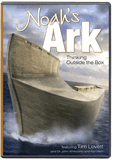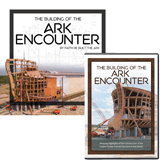
Feedback: Could Noah’s Ark Float Without Problems?
Part 1
Tim Lovett examines a blogger’s claims that Noah’s Ark would have been unable to float safely.
A blog post titled “More Lies from Ken Ham” appeared as a May 12 posting on the website “The Bushy Tree.” A blogger named “Froggie” offered a scathing commentary on a Noah’s Ark article written by Tim Chaffey regarding AiG’s latest project, the Ark Encounter—a full-size Noah’s Ark to be built south of Cincinnati, Ohio. In reply to “Froggie,” Tim Lovett, who is the primary consultant for Ark theory and design on the Ark Encounter project, offers the following observations.
It’s nothing new to see an anonymous blogger taking potshots at Noah’s Ark and our Ark Encounter project, but this time we have a blogger—“Froggie”—who has written a longer-than-usual critique that also contains many misrepresentations. Thus, in this instance, we believed that a public reply to a posted criticism was warranted.
One of my founding rules of life is to eschew obfuscation; tell it the way it is in as simple and factual way as possible. Occam’s Razor and all that; and sure, I am often guilty of oversimplification, but that’s the way it is here at the pad. So it is no surprise that politicians and commentators on religion incur my ire on a daily basis with their spin. In the case of Ken Ham, I can barely stand to read any more of his mephitic rhetoric, yet about once a week I find myself perusing his website, AIG.
Once a week? And perusing, no less? You should have a good idea of creationist teaching then.
For claiming to bring things to light in such a simple way, you use a lot of complicated words. Furthermore, an atheist who has “founding rules of life” and morality, which produce guilt and reasons to oppose immorality, doesn’t sound like a consistent atheist where rules and morality are optional.
It is usually just more of the same distortions and obfuscation of valid science, but a couple days ago he again tried to make a case for the reality of the myth of Noah’s Ark.
We are not discussing the myths of Noah’s Ark—though there are hundreds of them represented in Flood legends across the globe. Instead we are talking about the real Ark, as discussed in the Scriptures. By the way, you forgot to mention the distortions and obfuscation behind the myth of human evolution.
First of all, I always refer to anything from the AIG as being from Ken Ham because all of the commentators on his site have signed an agreement with the Hamster to publish only material that he has personally endorsed.
This is incorrect. Furthermore, Mr. Ham does not have time to personally endorse the many pieces of content Answers in Genesis produces. Everyone, including Mr. Ham, is subject to the Statement of Faith that was created by a board of directors, and all of the content should be consistent with this document.
Ken Ham is the leader of this sect of fundamentalist, bible literalist Christianity
Not so—each Christian working at Answers in Genesis (or working with us) is actually subject to his own church denomination and ultimately to Christ. We have Baptists, Lutherans, Presbyterians, etc., and this ministry affirms the great confessions of faith held by the church for 2,000 years. We aren’t teaching anything new but those things Christians have adhered to for centuries. Ken is the president and CEO of just one parachurch organization (Answers in Genesis) within the larger realm of biblical Christianity.
and nothing is posted that does not agree with his personal interpretation of scripture.
Not so again. There are things within creation that we debate and so various interpretations of Scripture are permitted.
Criticisms of Noah’s Ark
Having said that, the article was supposedly written by one Tim Chaffey. The line that especially caught my attention was:
“I don’t think there are many skeptics and critics of Noah’s Ark who would claim that it couldnt float—at least initially. Many large wooden vessels have been constructed that have floated without problems.”
I might agree with the first sentence, and furthermore, I agree that the Ark would float quite well, as wood will do, after it broke into pieces after the first few minutes afloat.
But the second sentence is problematic.
Many large wooden vessels have been constructed that have floated without problems.”
Oh? Well, let us have a look at those vessels.
Ham’s/ Noah’s Ark would float in still water for a short spell, but due to the large dimensions, and the fact that the wood will have joints every 20 feet, lengthwise
What an odd restriction, as if Noah has to buy his wood from the local hardware store. While 20 feet (6 m) is convenient for wood carried by truck, shipbuilding is different—especially in the old days when big trees were more common. Even as recently as a 1918 publication, lumber was available in lengths up to 140 feet (43 m).1 No shipbuilder would comply with your limit of 20 feet. Scarfing large sections will use up at least 8 to 10 feet (2 to 3 m), and you need to scarf both ends.2 This would produce a keelson of nothing but scarfs!
If the ancients couldn’t handle big things, what will you do about Stonehenge, Easter Island, Egyptian pyramids, and huge obelisks?
Or perhaps you mean that twenty feet was the best Noah could find in the Middle East. The Ark landed there, but this was completely unrelated to where it was built because “the ark moved about
” (Genesis 7:18). “Gopher wood” doesn’t have to be a desert acacia or even a cedar of Lebanon. It could just as well have been Douglas fir, yellow pine, or even teak.
Or maybe, you have been busy perusing the Panda’s Thumb website and copying a twenty-foot limit from Stevaroni’s four-men-carrying-a-beam “proof.”3 If the ancients couldn’t handle big things, what will you do about Stonehenge, Easter Island, Egyptian pyramids, and huge obelisks? Surely, you are not suggesting aliens?
and hundreds of joints between the planks heightwise,
No, with planks 14 inches (36 cm) wide on an Ark 45 feet (14 m) high, there would be 38 joints.4 However, the Ark’s planking was probably closer to 24 inches (61 cm) wide, as seen in a shipwreck discovered off Australia.5 So “hundreds” is actually 22 or so.
even small swells would rip it apart in hours due to all the mechanical moments and torque action over that length.
In structural terminology, “moment” is “torque.” Now, it would have made more sense if you had said bending moments and torsion, the two primary loads on a ship’s hull.
Next, there will be so many linear joints that as soon as the boat started to stress and torque, the joints would open instantly and leak.
Linear joints? You probably mean “longitudinal joints between planks,” maybe. We can only guess.
I won’t even discuss the effect of wind on a structure three stories tall, of that length.
But I have to discuss it because your assumptions are wrong. A loaded ship sits in the water not on the water, as you imply with all three levels exposed to the wind. Try a more realistic halfway into the water, as suggested by real-life ship researchers one would read about if one perused the AiG website.6
You also assume the wind is side-on to this ship (known as a beam sea). This is yet another topic explained on the AiG website.
Come back next week for my response to whether wooden ships are reliable as I continue to analyze this critique of our article.
With regards,
Tim
Footnotes
- Harvey Cole Estep, How wooden ships are built; a practical treatise on modern American wooden ship construction, with a supplement on laying off wooden vessels (Cleveland, OH: The Penton Publishing Co., 1918) p. 8. “Structural timbers of Douglas fir, 18 x 18 inches in section and 120 to 140 feet long, may be obtained from mills at any time, and timbers 36 inches square and 80 or 90 feet long are equally available. By the use of such timbers, the largest boats can be constructed with a minimum of splicing and scarfing, which not only reduces labor costs but materially increases the strength or seaworthiness of the vessel.”
- Henry Hall, Models and Measurements (1883), notebook in possession of Penobscot Marine Museum, Searsport, Maine. “Scarfs generally eight feet long … Great Republic whose scarfs were 10 feet long.”
- Stevaroni, comment on “FT Magazine on AIG’s Ark project” Panda’s Thumb, http://pandasthumb.org/archives/2013/04/ft-magazine-on.html#comment-panels. “Stevaroni” disallows any lifting device and claims 20 feet (6 m) as a limit for a 10x10-inch (25x25-cm) beam manually handled by four men (i.e. Noah, Shem, Ham, and Japheth).
- William L. Crothers, The American-Built Clipper Ship, 1850-1856: Characteristics, Construction, Details. (Camden, ME: International Marine, 1997). The Great Republic, a 335-foot (102 m) Clipper ship built in 1853, had planking (common planks) 14 inches (36 cm) wide by 6 inches (15 cm) thick.
- Jack Loney, Wrecks Along The Gippsland Coast, 8th ed. (Portarlington, Victoria, Australia: Marine History Publications, 1994). Regarding 24-inch planking, Loney notes, “Some of the kauri planks measured forty five feet in length by two feet in width, and the vessel appeared to be double planked suggesting that the vessel may have been built for navigation through the ice.”
- S. W. Hong, S.S. Na, B.S. Hyun, S.Y. Hong, D.S. Gong, K.J. Kang, S.H. Suh, K.H. Lee, and Y.G. Je, “Safety Investigation of Noah’s Ark in a Seaway,” TJ (now published as Journal of Creation) 8(1):26–36, 1994, http://www.answersingenesis.org/articles/tj/v8/n1/noah. While studying the proportions and scale of Noah’s Ark, the research team at KRISO chose a draft (d) of half the hull depth (D).
Recommended Resources

Answers in Genesis is an apologetics ministry, dedicated to helping Christians defend their faith and proclaim the good news of Jesus Christ.
- Customer Service 800.778.3390
- Available Monday–Friday | 9 AM–5 PM ET
- © 2025 Answers in Genesis





